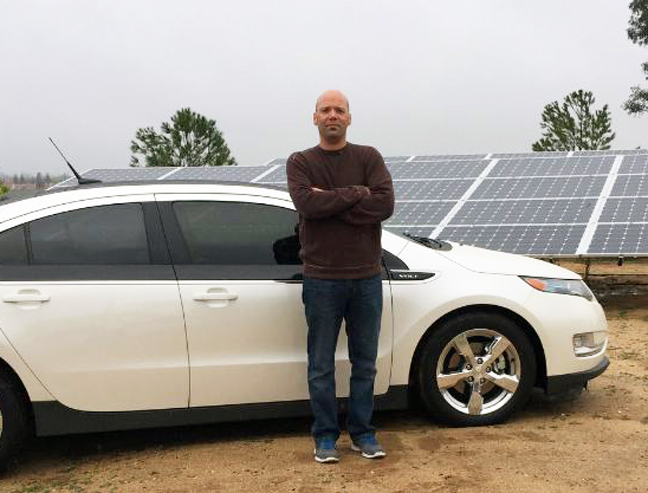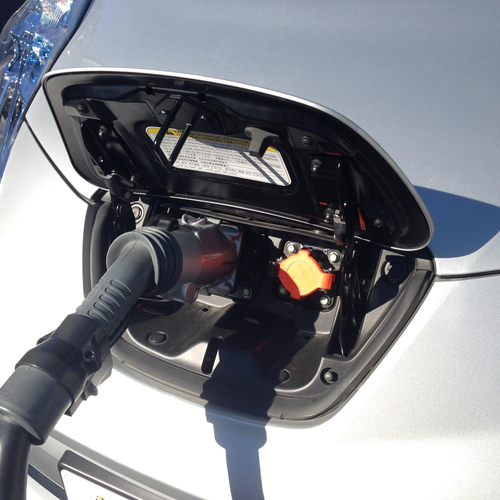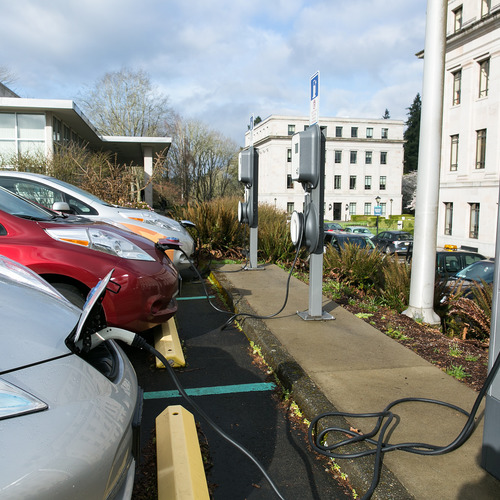
Image Credit: ProtectOurRates.com
Some electric vehicle owners in California think they’ve been sideswiped by changes to a utility rate plan that helped them pay for their photovoltaic (PV) systems.
Vehicle owners like Joseph Gray are critical of a decision by the California Public Utilities Commission allowing Southern California Edison to alter a time-of-day rate structure and make it harder for them to recoup the cost of photovoltaic systems installed to keep their vehicles charged, Greentech Media reported.
Gray bought his first electric vehicle, a Chevy Volt, in 2011 and then spent another $68,000 out of pocket for a PV system to keep it charged, Gray says at a website called ProtectOurRates. The size of the system and payback calculations were based on a rate plan from Southern California Edison (SCE) called TOU-D-TEV.
“When you produce your own solar during peak, and send it back to SCE, they would give you a credit equal to what they would have charged you for the same energy,” Gray says. “Also, because I shifted a lot of my energy use to super off peak, I was banking a lot of credit during the day which more than covered my usage in other dayparts. “
Gray modeled his system to break even in 6 1/2 years, and actually finished his first year with PV with a $300 surplus. The SCE rate changes threw those calculations out the window.
Rate changes lead to a petition drive
Among the changes SCE made, Gray says, was to shorten the summer season from seven to five months, and shift peak hours from 10 a.m. to 6 p.m. to 2 p.m. to 8 p.m.
“Whether a wild coincidence or not, these changes will drastically impact existing solar owners as our systems will only earn a fraction of the credits we have earned in the past,” Gray writes at the website. “SEC has figured out a way to stop paying us for our solar generation, at present rates, at a time when most of us have only recently made our solar investments in good faith and with no knowledge that these rate changes were about to occur.”
Gray argues the TOU-D-TEV plan should be grandfathered. The website includes links to local state representatives, the Public Utilities Commission, and the governor’s office as well as an online petition to roll back the decision.
For its part, SEC told Gray in a letter he would be transitioned to a new rate plan in February that would actually work to his advantage.
“These new rate options may help to reduce your electric vehicle charging costs because they offer a longer off-peak period when electricity prices are the lowest, and a shorter on-peak period when electricity prices are the highest,” SEC told him.
Weekly Newsletter
Get building science and energy efficiency advice, plus special offers, in your inbox.















12 Comments
Why should the utility pay you a dime more than
the wholesale price of the electric you are generating? You are producing a wholesale commodity and are still getting a retail price for that commodity just at a different part of the day. You should shut up while you are still ahead and are still able to force your neighbors to pay too much for your "religious" choice.
Response to B.W.
B.W.,
Q. "Why should the utility pay anyone a dime more than the wholesale price of electricity?"
A. For two reasons.
1. Because a local electric utility is granted a monopoly, its rates are tightly regulated by a board that must make sure that the utility serves the public and serves the public's aims.
2. In some states, elected legislators have decided that incentives that encourage the installation of renewable energy equipment (like PV) serve the public good by reducing fossil fuel emissions and speeding our transition to a renewable energy future.
Response to Peter Hastings
Peter,
If you are ideologically consistent -- and I hope you are -- then I trust that you are spending at least as much time battling and opposing the many tax incentives enjoyed by the fossil fuel industry as you are complaining about renewable energy incentives. After all, these fossil-fuel industry incentives are far larger than those devoted to PV or wind -- so the "bribes" offered to oil companies are surely worth opposing.
Another response to Peter Hastings
If you want to be philosophical about it, why do you think there is a difference between codes and incentives?
Codes impose costs, relative to the cost of building a non-compliant building, and they do this on the basis of protecting the public interest.
Incentive programs likewise imposes costs, again justified by the public interest served by the incentivized activity.
The flip side of the argument is that building a substandard building creates externalized costs which would be borne by the community, and the code requirements prevent (or at least reduce) this impact. Similarly, the use of fossil fuel energy imposes externalized costs on society; using renewable energy instead again reduces this externalization.
Predictibility
If you want to accurately predict cashflow, payback, etc, you have to be able to control as many of the variables as possible. Utility rate changes throw that out the window. To really accurately be able to predict solar cost-effectiveness long-term, you almost have to go off-grid. You never know when the rules of the grid are going to change. As many point out, small-scale solar producers are currently getting a deal that benefits them to the cost of everyone else. That can't possibly continue long-term as the number of beneficiaries (solar generators) increases. Paying to add electricity to a grid during peak hours is not unthinkable at some point, as with enough distributed peak generation and no great grid solution to the problem of storage, excess electricity actually becomes a waste product that the utility needs to get rid of if you aren't able to turn off your system. And they certainly aren't going to give you a credit for this electricity if it's of no value to them.
Response to Nathaniel G
Nathaniel,
You wrote, "Paying to add input to a grid during peak hours is not unthinkable at some point."
If you are talking about PV, that's nonsense. If my local utility stops paying for PV power at certain times of day -- say, 2:00 pm to 4:00 pm -- all I would have to install is a disconnect switch connected to a timer. Why would I pay the grid to accept my PV power? Disconnecting a PV array from its load does no harm to the PV modules.
If the utilities were doing EV charging right...
... they would be controlling the charger and using the car battery load to provide voltage & frequency stabilization for the local grid when it's plugged in, and either PAY him (but at least not charge him) for the energy, since using battery loads for the ancillary service of grid stabilization is FAR AND AWAY cheaper than than using fast ramping spinning reserves ( and power dumping loads- big resistive heaters) for that purpose.
This is in fact how Tesla is making money on their "free" super-charging stations. The batteries required at the station for quick-charging can even run both ways (unlike the car load) , and intermittently drive the grid, as well as take power off the grid. The bulk power can charge during true off-peak conditions(a measured condition, not some clock determined time period). Some analysts believe that this is the core business model for Tesla that will drive their profits- grid stabilization services, not margin on selling cars.
This isn't pie-in-the sky stuff. The L.A. Air Force base is developing an all plug-in (some hybrid, some EV) fleet, and collecting about $100 / month PER CAR for providing the grid stabilzation services, with both smart car charging and vehicle-battery-to-grid power controlled by the local utility.
http://www.af.mil/News/ArticleDisplay/tabid/223/Article/554343/af-tests-first-all-electric-vehicle-fleet-in-california.aspx
The value of rooftop solar to the grid varies with market, but in most markets (even in CA) the value of offsetting peak load and taking the stress off infrastructure is higher than the retail rate of the power produced. In several SoCal locations it would be advantageous if the utilities were allowed to selectively subsidize rooftop solar more in some neighborhoods than others, since it would eliminate the need for substation upgrades. In NY this sort of selective subsidy to avoid even higher infrastructure cost is a hot topic under the ongoing drastic regulatory changes, but it's likely to become the standard model of PV subsidy in many areas after the federal tax subsidy lapses. The only place in the US where PV saturation has hit a point where it actually imparts a COST to the utility is certain neighborhoods on Oahu that back-feed the substations during sunny days. One low / no-cost solution to THEM would be electric vehicle chargers under utility control, with some state subsidy to get EVs deployed fast enough to keep up with the solar that is getting deployed.
Putting the smarts in these devices is cheap. Changing regulations takes time. CA is ahead of most states on this, but that's not to say the CA-ISO has it perfectly dialed- it's a rapidly evolving scenario. With enough EVs and smart-chargers many gas-fired peakers will become stranded assets, which isn't going to make the shareholders of investor owned utilities who thought they had a 40 year guaranteed profit on that capital happy, but getting cheaper and better grid stability and higher grid reliability would make the ratepayers happy. The challenge for the utilities it to adapt their business models quickly enough to not implode. In CA I expect most utilities will survive this grid-evolution, in some other places where the utilities are state-wide vertically integrated monopolies, maybe not. In GA where they are making a HUGE capital bet on new nuclear power plants, by the time they load the fuel rods in the those suckers rooftop solar and grid storage will be cheaper than the rates required to pay for that power. With sufficient price pressure, those with the access to the sun & capital can cost effectively disconnect (not that they will, at least not right away.)
Electricity consumption is going DOWN in this country (except in the Texas /ERCOT grid). Adding EV loads may increase total consumption slightly, but if done right, should result in lower cost to ratepayers since low capacity factor peakers will all but go away.
The shifting rate structured in CA are really little more than bumps along the road to utility V2.0, where the grid is operated as a 2-way service for multiple types of distributed generators (including battery-to-grid), and controllable/sheddable load. The result will be a cheaper, more reliable grid, but there will be lots of regulatory & rate glitches like this as it evolves. The spot-wholesale prices of power will fall, and high peaks will be all but eliminated when real-time pricing information is available to all players, rather than dumbed down guesstimates like time-of-use block rates.
Expect demand-charges to eventually be assessed for the peak 15-30 minute draws as the primary means of paying for grid infrastructure, as it commonly is for large commercial customers right now. With tiered block rates or time-of-use rates based only on energy used, there is no way to correctly assess the correct infrastructure charges, which is a cross-subsidy from steady sipper customers to those with big short-term loads. It's the house with the 8 ton air conditioner that only takes a half-hour to chill a house from 90F to 70F that is maxing out the grid infrastructure to the stops, not the house the the modulating 2-ton that runs all day and uses the same amount of power.
Pothole: Selling PV surplus to the grid
I'm for PV. The idea of driving courtesy of sunlight is appealing.
Here, the vehicle owner is pleased with his electric car and the PV system he uses to recharge the car batteries. Quite admirable. He's less pleased with the value of surplus electricity he now markets to the grid. So, the automotive green energy project is working. The complaint seems to be how much other Utility customers and tax payers pay to subsidize the project. It sounds like the joy of energy independence and environmental correctness is not sufficiently satisfying for the car owner (he doesn't look all that satisfied and it says there's fuming). The real motivation seems to be the avarice that comes from acquiring and spending other people's money. Too bad. Driving on sunlight is still a lovely idea.
I'd say if the Utility were a signatory to the contracts about this automotive project, they should be legally required to meet their (our) obligations. Meanwhile, the Utility is not needed to make the car go. It's a celebration of driving on sunshine. Bon voyage!
Response to W.D.
W.D.,
If I understand the case correctly, Joseph Gray bought a PV system based on financial calculations that were based on a net-metering agreement that has changed since he made the purchase. It's not surprising that he is disappointed.
This case should serve as a warning to PV system owners that, unless their net-metering contract specifies a time period under which the contract provisions will remain in force, PV owners must shoulder the risk that their local utility will decide to pay them less in the future for their excess power than they are paying them now.
There is no need to berate Joseph Gray because "other utility customers and taxpayers are subsidizing his project." In fact, it's very difficult to determine a fair rate for peak power. It's easy to develop an argument that shows that most utilities are paying too little for peak power generated by PV systems.
For purchasers of PV systems to be able to make an intelligent decision, they need to be assured that utilities will honor their net-metering agreement for a set period of time. In the absence of such an agreement, it's hard to know whether these investments make sense.
Response to Brent Eubanks
Granted, but in one case the cost is imposed on the purchaser of the house, who has the most to gain from a code-compliant house in terms of safety, efficiency, ease of resale etc. In the case of incentives, the cost is imposed, as a tax, on a populace which benefits only peripherally from code-compliant houses.
Long-term Planning
It is demonstrably unwise to expect politically-determined incentives to stay stable for any length of time. As it says in investment ads (at least in some parts of the world) 'returns may go down as well up'. All such incentives are, in practice, a means of transferring money from the many (who have no choice in the matter) to the few (who do). Obliging people to do good (as in Building Codes) is fine. Bribing people to do good (as in environmentally-draped incentive schemes) is simply immoral since the people doing the bribing aren't using their own money.
Edit to correct typo
Response to Peter Hastings
However, to continue your line of reasoning, everyone pays (though some more than others) for air pollution and other externalized costs associated with traditional fossil fuels, so it's not unreasonable for them to all help support the transition away from fossil fuels.
Yes, it would be better to force the fossil fuel companies to internalize their costs. But as a matter of practice, that's just not going to happen. It's politically untenable, for one thing. More significantly, our entire economy is premised on the idea of cheap energy. Transitioning from that to a more rational basis is kind of like trying to rebuild an airplane in flight.
Log in or create an account to post a comment.
Sign up Log in